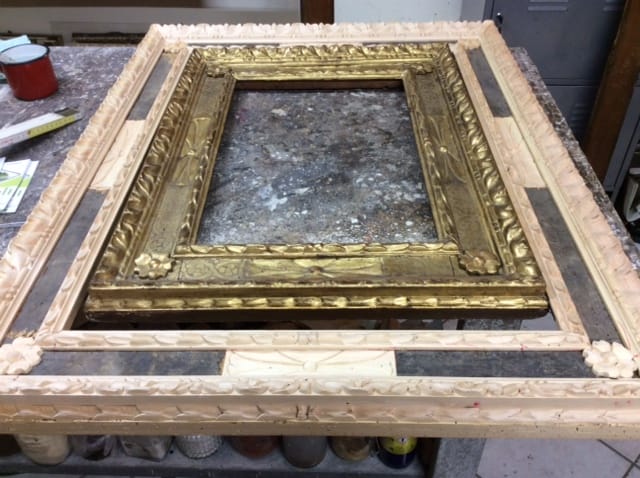Discover the allure of ANTIQUE GOLD PICTURE FRAMES and elevate your art or photographs with a radiant, historically rich display.
Have you ever found a piece of artwork or a beloved photograph that deserves a frame as magnificent as the image itself? ANTIQUE GOLD PICTURE FRAMES capture that sense of grandeur, connecting the timeless appeal of precious metals with the historical significance of artisanal craftsmanship. In this guide, you’ll uncover what makes these frames so special, how to spot authentic details, and best practices for styling, restoration, and more. By the end, you’ll have all the knowledge you need to select, preserve, and proudly display a gold-embellished piece of history.
Here’s how to make the most of antique gold picture frames:
- Why Antique Gold Frames Are Unique
- Identifying Genuine Gold Finishes
- Popular Eras and Design Motifs
- Assessing Frame Condition
- Restoration Basics for Gold Frames
- Matching Your Art or Photos
- Decor Tips for Displaying Gold Frames
- Where to Find Authentic Gold Frames
- Working with Specialists for Customization
These sections guide you from understanding their timeless appeal to ensuring each piece complements your art beautifully.
Continue reading to discover how these ornate frames can become show-stopping centerpieces in your home—while preserving the craftsmanship and history behind them.
1. Why Antique Gold Frames Are Unique
Antique gold frames aren’t just eye-catching; they represent a fusion of artistic heritage and timeless luxury. Gold leaf or gilded finishes have adorned frames for centuries, stemming from a desire to emphasize sacred or high-value artworks. Historically, only the most skilled artisans worked on gold frames, using methods passed down through generations. This legacy imbues each piece with a distinct character that mass-produced frames simply can’t replicate.
Beyond their craftsmanship, the glow of an antique gold finish is unlike any contemporary metallic spray or synthetic coating. Genuine gold leaf has a rich, warm quality that subtly reflects light, giving your artwork a soft luminosity. Over time, these frames often develop a patina—small signs of aging like delicate cracks or gentle darkening—which adds layers of visual depth. Far from being imperfections, these tiny marks chronicle the frame’s past life and enhance its authenticity.
People often select antique gold frames when they want to create a focal point that conveys refinement. Whether placed around an heirloom portrait, a modern abstract painting, or even a treasured family photo, these frames strike a balance between opulence and tradition. Rather than overshadowing the art, they offer a complimentary glow that amplifies details and invites you to take a closer look. All told, the uniqueness of an antique gold frame comes from a blend of storied craftsmanship and the graceful passage of time, making each piece a miniature work of art in itself.
2. Identifying Genuine Gold Finishes
When exploring ANTIQUE GOLD PICTURE FRAMES, one crucial element is verifying the authenticity of the gold finish. True gold leaf—especially from older frames—has a slightly irregular surface and a gentle sheen. While modern gilding techniques can mimic this look, there are a few telltale signs that help confirm an authentic antique finish.
First, inspect the texture closely. Genuine gold leaf often shows subtle overlapping lines or minuscule creases, where sheets of leaf were manually applied. In contrast, contemporary paint or metallic foil may appear too uniform or glossy. Next, look for areas where the surface has worn away. If the underlying material is a reddish clay known as “bole,” you’re likely dealing with traditional water gilding—a technique prized for its warmth and depth. If you see a white or gray base, it could be gesso or resin beneath a more modern coating.
Patina also plays an essential role. Natural aging causes soft tarnishing or oxidation along edges and carved recesses. This effect can’t easily be replicated overnight, so frames that boast a perfectly shiny surface without even minor fading or discoloration might have been recently refreshed—or could be a reproduction. Lastly, consider the overall craftsmanship. True antique gold frames often include intricate hand-carved details, small variations in symmetrical patterns, or slight asymmetries that point to a time when frames were made individually rather than on assembly lines. By piecing together these clues, you can feel more confident you’re investing in a genuine, historically resonant gold piece rather than a modern imitation.
3. Popular Eras and Design Motifs
Gold frames have been cherished through multiple design periods, each one leaving its own artistic imprint. During the Baroque era, for instance, frames were known for their dramatic styling—bold scrolls, swirling leaves, and heavily layered ornamentation. The glimmer of gold suited the grandeur of 17th-century Europe, where art patronage reached lavish heights. These frames often feature deep relief carvings that catch and reflect light from various angles.
The Rococo style followed, bringing a lighter, more playful approach to design. Asymmetrical shells, floral garlands, and curvilinear forms exemplify this 18th-century French aesthetic. Antique gold frames from this period can be especially elaborate, merging whimsical motifs with refined gilding techniques. In contrast, the Neoclassical movement of the late 18th to early 19th century favored symmetry and references to Greco-Roman architecture. You might find laurel wreaths, columns, or medallions carved delicately into slim gold frames—an elegant choice for portraits or historical paintings.
Moving into the Victorian era, frames often balanced machine-assisted patterns with hand-finished details, reflecting industrial innovations. Some of these later designs incorporate ornate ribbons and floral borders, but with a slightly heavier feel. Toward the early 20th century, the Art Nouveau movement introduced fluid lines and natural forms, sometimes blended with gold accents for a more modern take on gilded style. Familiarizing yourself with these eras not only helps you date your frame but also guides you toward the perfect match for your art. Whether you crave the regal opulence of Baroque or the refined geometry of Neoclassicism, each design motif tells a unique story—one that can harmonize beautifully with contemporary or traditional artwork alike.
4. Assessing Frame Condition
Before investing in an antique gold frame, take a careful look at its condition. Like any heirloom, wear is part of its appeal, but you want to ensure that any flaws are manageable and won’t undermine the frame’s structural integrity. Start by testing the joints: gently press each corner to see if it feels secure or wiggles under pressure. Many older frames are assembled with nails or wooden pegs, so slight looseness might be resolved with a skilled restorer’s touch.
Next, examine the gold leaf or gilding for signs of flaking or large patches of missing material. Some wear is natural, especially on edges and raised details, but extensive damage could mean costly repairs. Look also for cracks in the wood or plaster base (often referred to as gesso) beneath the gold finish. Small hairline cracks can be a normal result of aging, but deeper fissures might require more complex restoration.
Check the backside of the frame for evidence of insect activity, water damage, or old repairs. If the wood is severely rotted or crumbles under slight pressure, it could be a red flag that the frame isn’t salvageable—or at least would demand expert intervention. Don’t forget to confirm that the frame’s dimensions align with your artwork or can be adapted without losing valuable detailing. In short, balancing the frame’s age-related imperfections with your willingness to fund or undertake restoration ensures you’ll acquire a piece that remains both visually captivating and structurally sound.
5. Restoration Basics for Gold Frames
Restoring ANTIQUE GOLD PICTURE FRAMES can be deeply rewarding but demands patience and precision. If you’re dealing with minor nicks or areas where the gold leaf has chipped, you can often address these problems yourself. Start by cleaning the surface gently with a soft brush or dry cloth. Avoid harsh chemicals or aggressive scrubbing, as you may strip away more gold or damage the underlying gesso.
For flaking gold leaf, a specialized adhesive called “size” can help re-adhere loose areas. When needed, you can also apply new gold leaf to patch small blemishes—though color-matching to the older surrounding finish can be tricky. If you must replace missing ornamentation or carved details, materials like wood putty or epoxy-based compounds can work for subtle fills, but replicating ornate designs often calls for an expert sculptor or restorer.
In cases where the frame has deeper structural issues, such as severe wood damage or extreme warping, seeking professional help is often the safer route. A skilled conservator can re-balance corners, treat insect infestations, or rebuild missing sections without ruining the piece’s historical integrity. Once restored, periodic light dusting and stable display conditions—avoiding direct sunlight, humidity fluctuations, and extreme temperatures—will keep your rejuvenated gold frame looking splendid for years. Remember that each small act of care helps preserve a chapter of artistic heritage, ensuring the frame’s story continues well into the future.
6. Matching Your Art or Photos
Selecting the right artwork or photograph for an antique gold frame can feel like alchemy—a harmonious combination of color, style, and emotional resonance. Start by considering the palette of your image. Deep reds, blues, and greens often pop against the warm luster of gold, while black-and-white portraits take on a timeless aura. Even bright, contemporary art can benefit from the contrast of a classic gilded border, creating a statement piece that bridges old and new.
Think about the theme or mood you want to convey. Ornately carved Rococo frames can complement romantic or floral-centric paintings, while a neoclassical frame might elevate a formal portrait. Don’t be afraid to experiment with juxtaposition: a minimalist abstract piece can truly shine in a lavish Baroque frame, capturing attention through unexpected synergy. If the artwork already has gold accents—maybe in the background or highlights—a matching antique frame can enhance these glints, making them more pronounced.
Size and proportion also matter. An oversized gold frame can swallow a small, delicate image, whereas a petite frame could look lost around a large canvas. Aim for a visual balance where the frame’s ornamentation doesn’t overshadow the artwork itself. For a more refined approach, adding a simple linen or silk liner can create a buffer between heavily carved edges and your art, highlighting each element’s best qualities. Ultimately, pairing your chosen image with a period-appropriate or intentionally contrasting frame underscores the power of thoughtful design, ensuring every glance resonates with style and substance.
7. Decor Tips for Displaying Gold Frames
When it comes to displaying antique gold frames, a little forethought goes a long way. Lighting can make or break the presentation, so consider where natural light hits your walls. Soft, diffused daylight can emphasize the gold’s rich patina, while harsh direct beams might cause glare or accelerate fading in delicate artwork. Installing a picture light or adjustable spotlight can create an intimate glow, drawing eyes toward the frame’s carved details.
Coordinate the frame’s finish with your room’s color palette. Gold pairs beautifully with neutral tones such as beige, cream, or light gray, allowing the frame to stand out as a focal point. If your walls are bold in color—deep blues, greens, or burgundies—the warm gold hue can provide a dramatic yet elegant contrast. In more minimal or contemporary spaces, a single gilded piece against a clean, white wall can function almost like jewelry, offering just a touch of old-world glamour.
Don’t feel constrained to hang your gold frames solo. Mixing multiple frames in a gallery wall can create an eclectic, layered look—just maintain a cohesive element like consistent spacing or shared color themes. Incorporating smaller gold frames on shelves or mantels also adds visual interest, especially if they complement decorative items like porcelain vases, candleholders, or vintage books. Remember, the goal is to let your antique gold frames shine in harmony with the rest of your décor, weaving history and beauty into the fabric of your home.
8. Where to Find Authentic Gold Frames
Hunting for genuine antique gold frames can be both exciting and challenging. Local antique shops and estate sales often carry a diverse array, letting you examine potential finds in person. Flea markets can yield hidden gems at reasonable prices, though you’ll want to be prepared to assess condition on the fly. For those seeking rarer or higher-end pieces, auction houses and specialized antiques dealers offer more curated selections, sometimes complete with provenance information.
Online marketplaces, from auction websites to social media groups, broaden your search considerably, but be cautious. Always request detailed photos, including close-ups of corners, ornamentation, and the back of the frame. Ask about returns, shipping insurance, and any existing restorations. Reputable sellers will typically provide transparent answers, ensuring you know exactly what you’re purchasing.
Architectural salvage stores are another avenue; older buildings often contained ornate gold frames on mirrors or paintings. While these may require restoration, they can be well worth the effort for a one-of-a-kind find. Ultimately, persistence pays off—learning to recognize authentic gold leaf and historical carving techniques will help you spot truly valuable frames, whether you’re browsing a bustling flea market or scrolling through online listings. And if you do spot that perfect, radiant frame? Don’t hesitate; true antique gold frames are timeless treasures that vanish quickly from the market.
9. Working with Specialists for Customization
Even when you find the ideal antique gold frame, it may need some tailoring to fit your chosen artwork. This is where professional framers and restorers step in. A seasoned expert can resize a frame—within reason—by adding or removing liners, adjusting rabbet depths (the inner lip where artwork rests), or carefully removing extra material. They’ll do so while preserving the original gilding and ornate details as much as possible.
Additionally, a specialist can help address any aesthetic mismatches. If the frame’s gold tone leans too bright for your artwork, subtle toning or patination can achieve a cohesive look. They might also patch minor gilding losses, re-gild corners, or fix loose ornamentation, making sure the final result exudes both authenticity and polish. Beyond the gilding, consider protective measures: UV-resistant glass or acrylic can safeguard your art, especially if it’s a photograph or delicate painting susceptible to light damage.
Throughout the customization process, communication is key. Share your vision—do you want a bold statement piece that contrasts with modern décor, or a seamless integration that complements existing period-style furnishings? Discuss your budget and timeline to avoid surprises. A professional’s goal is to maintain the frame’s historical character while creating a harmonious fit for your art. In the end, a little investment in expert craftsmanship ensures your antique gold picture frame stands as a masterpiece in its own right, beautifully safeguarding and showcasing what you love.
FAQ
Are all antique gold frames made with real gold leaf?
Not necessarily. Some are gilded with imitation leaf or gold paint. Inspect carefully for signs of genuine gilding, like bole underlayer or natural patina.
How do I clean my antique gold frame without damaging it?
Use a soft, dry cloth or brush. If deeper cleaning is needed, a lightly dampened cotton swab can help, but avoid chemicals or strong pressure.
Can an antique gold frame be resized to fit a smaller image?
Yes, within limits. A professional framer can add liners or adjust the frame’s rabbet, though severe downscaling could compromise ornamentation.
Is re-gilding a frame expensive?
It depends on the extent of damage and the intricacy of the design. Partial touch-ups are often more affordable than full re-gilding.
Will humidity or temperature changes affect an antique gold frame?
Extreme fluctuations can cause wood to warp and gilding to crack. Keep frames in stable conditions, away from direct sunlight and moisture.
Conclusion
ANTIQUE GOLD PICTURE FRAMES hold a unique capacity to enrich your art with a sense of history and luxury. Handcrafted and often lovingly worn by time, they bring character that modern frames seldom replicate. By learning to identify genuine gold finishes, exploring various historical styles, and understanding the nuances of restoration, you can confidently find or maintain a piece that resonates with your personal taste. Once matched with the perfect artwork or photograph, an antique gold frame becomes more than just a border—it’s an expression of timeless artistry, linking the past and present in a single, gleaming display.





